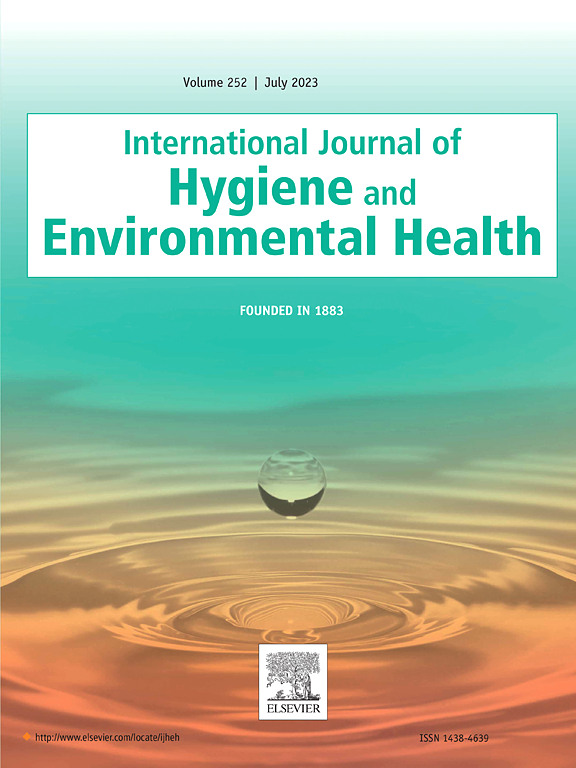血清48种元素组学与雌性繁殖力的关系:来自中国巢式病例对照研究的证据
IF 4.4
2区 医学
Q1 INFECTIOUS DISEASES
International journal of hygiene and environmental health
Pub Date : 2025-07-01
DOI:10.1016/j.ijheh.2025.114620
引用次数: 0
摘要
不孕不育是一个日益全球性的问题,暴露于与女性生育能力有关的各种因素;然而,对同时暴露于多种元素的影响缺乏全面的研究。在这项研究中,我们在孕前队列中使用了嵌套病例对照设计,检查了2019年至2022年期间试图怀孕的142名不孕妇女和139名对照组的血清样本。本研究采用电感耦合等离子体质谱法评估了48个因素,并通过弹性网络回归和贝叶斯核机回归(BKMR)等先进的统计技术确定了影响不孕风险的关键因素。采用广义加性模型(GAM)进一步探讨各因素的交互作用,并通过Kaplan-Meier和Cox回归分析各因素对妊娠时间(TTP)的影响。研究结果表明,较高水平的镉与不孕不育呈正相关,而铁、铯、锑和Y等元素可能具有保护作用。进一步的BKMR分析表明,所鉴定元素的混合物对不育风险的综合影响几乎是线性的,其中铁和镉是主要因素。研究发现,Cd和Fe之间存在显著的相互作用,低铁和高Cd水平与较高的不孕风险和较长的TTP相关。我们的研究结果表明,补充铁和减少镉暴露可以降低不孕症的可能性。这项研究强调了元素暴露对生殖健康的复杂相互作用。这些发现强调了对准备怀孕的妇女进行公共卫生干预以减少镉暴露和促进铁补充的潜在需求。需要进一步的研究来调查潜在的生物学机制,并在不同的人群中证实这些发现。本文章由计算机程序翻译,如有差异,请以英文原文为准。
Association between serum elementomics of 48 elements and female fecundity: evidence from a nested case-control study in China
Infertility is an increasingly global issue, with exposure to various elements linked to female fertility; however, comprehensive studies on the effects of simultaneous exposure to multiple elements are lacking. In this research, we used a nested case-control design within a pre-pregnancy cohort, examining serum samples from 142 infertile women and 139 controls who attempted conception between 2019 and 2022. The study assessed 48 elements using inductively coupled plasma-mass spectrometry and identified key elements affecting infertility risk through advanced statistical techniques, including Elastic Net Regression and Bayesian Kernel Machine Regression (BKMR). The interaction effects of elements were further explored using Generalized Additive Models (GAM), and their impacts on time to pregnancy (TTP) were analyzed through Kaplan-Meier and Cox regression analyses. The findings reveal that higher levels of Cd are positively linked to infertility, while elements like Fe, Cs, Sb, and Y may offer protective effects. Further BKMR analysis indicated that the mixture of identified elements had a combined effect on infertility risk in a nearly linear manner, with Fe and Cd being major contributors. A notable interaction between Cd and Fe was found, where low Fe and high Cd levels were associated with a higher risk of infertility and a longer TTP. Our results suggest that Fe supplementation and reducing Cd exposure could decrease the likelihood of infertility. This study underscores the complex interactions of elemental exposures on reproductive health. These findings highlight the potential need for public health interventions to reduce Cd exposure and promote Fe supplementation for women preparing for pregnancy. Additional research is required to investigate the underlying biological mechanisms and confirm these findings across various populations.
求助全文
通过发布文献求助,成功后即可免费获取论文全文。
去求助
来源期刊
CiteScore
11.50
自引率
5.00%
发文量
151
审稿时长
22 days
期刊介绍:
The International Journal of Hygiene and Environmental Health serves as a multidisciplinary forum for original reports on exposure assessment and the reactions to and consequences of human exposure to the biological, chemical, and physical environment. Research reports, short communications, reviews, scientific comments, technical notes, and editorials will be peer-reviewed before acceptance for publication. Priority will be given to articles on epidemiological aspects of environmental toxicology, health risk assessments, susceptible (sub) populations, sanitation and clean water, human biomonitoring, environmental medicine, and public health aspects of exposure-related outcomes.

 求助内容:
求助内容: 应助结果提醒方式:
应助结果提醒方式:


